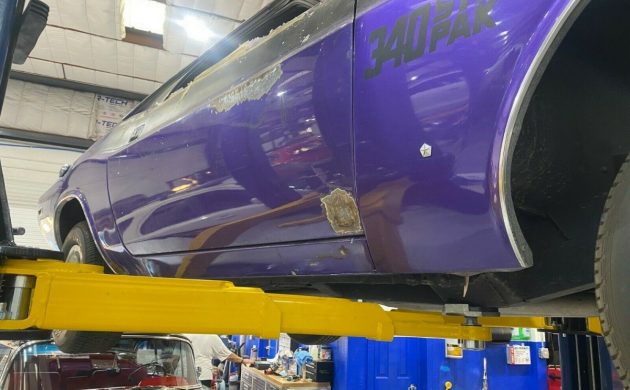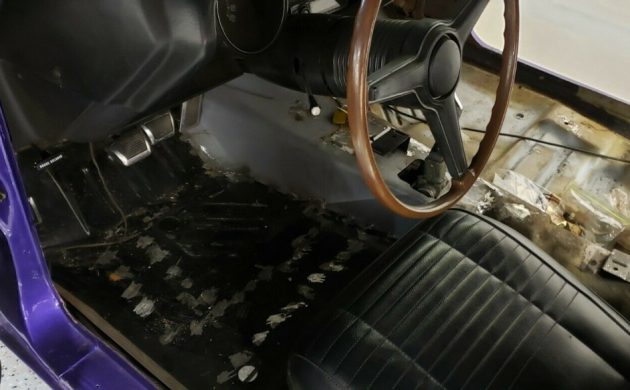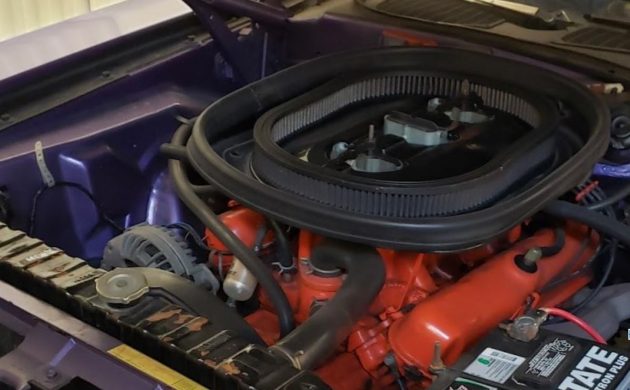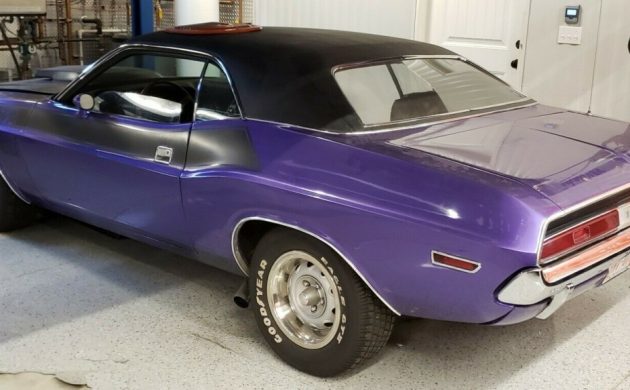While it might currently wear one of the most desirable colors ever to grace the panels of any Mopar offering, the buyer of this rare 1970 Dodge Challenger T/A will have some decisions to make. The rest of the car is original, but the car has received a color change. It needs some minor bodywork, so that could represent an opportunity to return the vehicle to its former glory. Located in Phoenix, Arizona, you will find the T/A listed for sale here on eBay. While the bidding has rocketed to $30,211, the reserve hasn’t been met.
When the Challenger rolled off the production line, Light Gold Metallic paint graced its panels. It also featured a Black vinyl top, and this remains intact. A previous owner performed a color change to Plum Crazy, which probably seemed like a good idea at the time. However, the relative rarity of the Challenger T/A would seem to make the idea of returning the car to its original color an option worth considering. The company offered rarer derivatives of the Challenger during the 1970 model year, but Dodge still only produced 2,539 examples of the T/A. Out of a total production run of 76,935 cars, that represents a low take-up rate. The body is generally in good condition, with the area that you see on the passenger door being the only known damage to have ever been inflicted on the vehicle. This is minor and repairable, and the car is currently sitting in a shop as the owner had intended to address this. Instead, he has chosen to part with the Challenger, so that task will fall to the buyer. That could present the golden opportunity to restore the Dodge to its original appearance. It seems that all of the distinctive and unique T/A components remain intact, including the fiberglass hood with the enormous scoop. The chrome and trim are in good order, as are the original Rally wheels. The passenger door glass was broken when the damage to the door occurred, but the owner has replaced the glass in both doors to maintain a consistent appearance.
There are a couple of minor rust spots that the owner has had repaired, and these will need to be finished. These were only small pinholes and didn’t need a lot of work. The owner has inspected the T/A thoroughly, and he has been able to find no evidence of any rust or any previous repairs. The exception is this section of the front floor that you can see in this photo. The section wasn’t rotten, but it was soft. That led a previous owner to perform the repair that you see here, and finishing it to a high standard should not be hard. The owner doesn’t offer many photos of the interior, but it does appear to be complete. Most of the Black trim is in good order, but he does include a new carpet set and a new console in the sale. There are also replacement decals for the woodgrain sections in the door trims. It appears that there have been no aftermarket additions, so getting the interior back to its best is a task that the buyer could tackle in a home workshop.
Now we get to the crux of what made the Challenger T/A an extraordinary car and another example of a manufacturer understating the truth regarding power outputs. The engine bay is occupied by a 340ci V8 that Dodge treated to the legendary Six-Pack induction system. The company produced the vehicle to compete in Trans Am competition. While it didn’t achieve any outright wins, Sam Posey managed to finish 4th overall in the series behind the wheel of a Challenger prepared and run by Ray Caldwell’s Autodynamics Race Shop. Dodge claimed a power output of 290hp from this engine, but the reality was quite different. Plenty of people in the know, including some experienced contemporary motoring journalists, placed the actual output figure at 350hp. Buyers could choose to hook a TorqueFlite transmission to the back of this V8, or as is the case with this car, a 4-speed manual unit with a Pistol Grip shifter. This car also features the obligatory power front disc brakes, power steering, a Sure Grip rear end, and the distinctive side exhaust outlets. Performance figures were all that you might expect from a car like this. It could demolish the ¼ mile in 14.5 seconds, while it would eventually run out of breath at 146mph. Interestingly, the VINs on the vehicle and the engine block don’t match, but they are out by a mere 73 cars. It isn’t clear whether this was due to a mistake on the production line or whether the vehicle has received a swap at some point. With the two figures being so close, I would be tempted to consider the former scenario the most likely. The Challenger had been sitting for an extended period, but the owner had a specialist revive it. He does provide access to a video of the Dodge with the motor running, and that 340 sounds crisp and clean.
The bidding on this 1970 Dodge Challenger T/A opened at $999, but it took a mere 36 hours to rocket beyond $30,000. It’s easy to see why because the T/A is a rare car that offers its owner neck-snapping performance. Even though this one will need some work to return to its former glory, it doesn’t appear that this will be a significant undertaking. With those thoughts in mind, I wouldn’t be surprised if the bidding kept going beyond $40,000, while a figure of $50,000 is not out of the question. I’d love to think that one of our Barn Finds readers will make a bid for the Challenger because I’d like to see this car when it is complete. Do we have any takers out there?









Apparently, the repaint was to a high standard, as it looks as though the car came that color from the factory. (IMO) If you’re buying the car as an investment, then return it to the original color; OTH, if you’re buying it for love of the car and because you missed the first chance around (I’d) leave it Plum Crazy. This appears to be a really good buy, and the bids will surely rise!
GLWTA!! :-)
Without some kind of documentation that shows the car was delivered with a mis-matched engine VIN, it might as well be 73,000 units off. Nobody is going to accept it as the original engine.
You are right. Rare and easily identifiable performance engines turn up for sale quite often, occasionally they find their way into the car they started life in, more often they go into a clone or the same make and model so that owner can claim it’s “correct”. In the late-80’s I had a 1970 Firebird with the wrong engine, I bought a 1970 Formula for parts, they were just over 100 cars apart on the assembly line, eventually winding up in the same town though one had been sold new in Los Angeles, the other in the SF Bay Area. I sold the engine from to parts car to someone who was looking for a “correct” engine for his Formula. No serious collector will believe that engine started life in that car.
Steve R
EXACTLY. It’s just another car, to me. If the numbers don’t match I will never be interested except, perhaps, to flip.
The seller should post a photo of the engine stamp. If it is a true TA six pack engine it will have TA340 cast in the block.
Today , purple Challengers are like red SS Camaros ; there weren’t many made , and there probably 10 times more around now than when they were new. So much so that when I see one today at a show I just assume its not the original color ! Seeing this in its original gold would really catch my eye today.
IMHO the only color uglier than that gold is the B2 Blue. That said, as a 2 time AAR owner I prefer the AAR over the Dodge. Just seems meaner somehow (and) you don’t paint a mean car gold.
I always though the Gold was a poor color choice for a Challenger. The PC Purple looks great and should stay. I loved the concept of the T/A. It had a beautiful body and Mopar Magic up front.
Frankly, at car shows, I could care less if any thing is number matching.
If the guy who built it showed good skill and care then, more power to him.
I love these cars but the 143 mph top end is fantasy. These things were geared more for acceleration than top speed, plus the engines were not that high revving. Last but not least, they were scary on the top end. The steering starts to feel like an overloaded pick up truck wondering all over the road. I assumed at the time that the big hood opening was catching so much air that it was lifted the weight off the front wheels. I still love them!!
Actually the 340’s were designed to rev high, plus the T/A’s were geared for road racing, not drag racing, so the top speed in the 140’s was a realistic number. Thank God the owner didn’t do the idiot swap to a big block like so many do. This car was designed to be a well balanced road racer, not a quarter mile beater.
Keep in mind this is the street version, I am sure the true race cars could spin up to 7000 but these TA engines were done by about 5600, not what I call high revving even for back then. The one I drove had the 3.91 rear end. It might could have hit 125 mph if you could keep it on the road but based on the rpm’s, it was about done at 120. The only other ratio was something like a 3.55, not much difference. Now the old Boss 302 that I drove back in the day felt like it could very well have hit 146, it’s engine would easily hit 7000 and the car was geared for speed. These were not, but they would blow the Boss 302’s doors off in the quarter mile.
Kowalski would like this one, but I wonder what he would think about Plum crazy? Very cool Challenger. Would love to rip thru the gears one time. Stay safe and good luck.
Cheers
GPC
Well, depending of you’re definition of “geared for road racing” My AAR came with the “optional” 3.91 rear. Most of these, Dodge or Plymouth were geared with 3.55. You might get to the 143 mph, but at maximum RPM. Just saying. I would think the Road racing cars were geared a little lower numerically.
Well, gearing for the street and gearing for whatever race track are two different things. There were short tracks that dictated shorter gearing than street gears and other longer tracks that dictated longer gears. Remember, these cars were only sold to the public for homologation requirements. Personally, I would have opted for the 3:55 gear set and a 4 speed manual if I could have.
I’m getting ready to sell my mint condition red AAR. In your opinions what is a solid price? It is so perfect that there is still ‘original air’ in the collapseable spare tire can.
Ken,
Lie most top-end, desirable muscle cars, the AAR has lost a good amount of value over the past few years.
Hagerty is a good place to get an idea of what you could ask, but they always seem to be on the high side.
Here are the AAR values from 1/19:
Here are the values as of today.
I’m not sure why they mention Hemi under Adjustments.
Good luck with your sale. You can probably tell that it is my favorite muscle car.